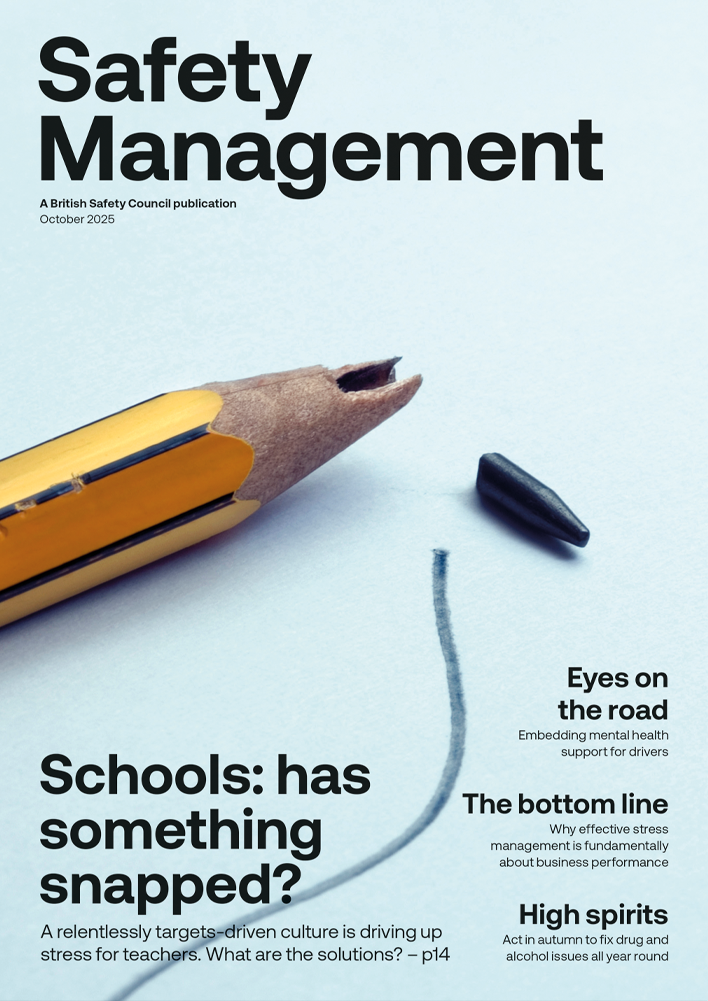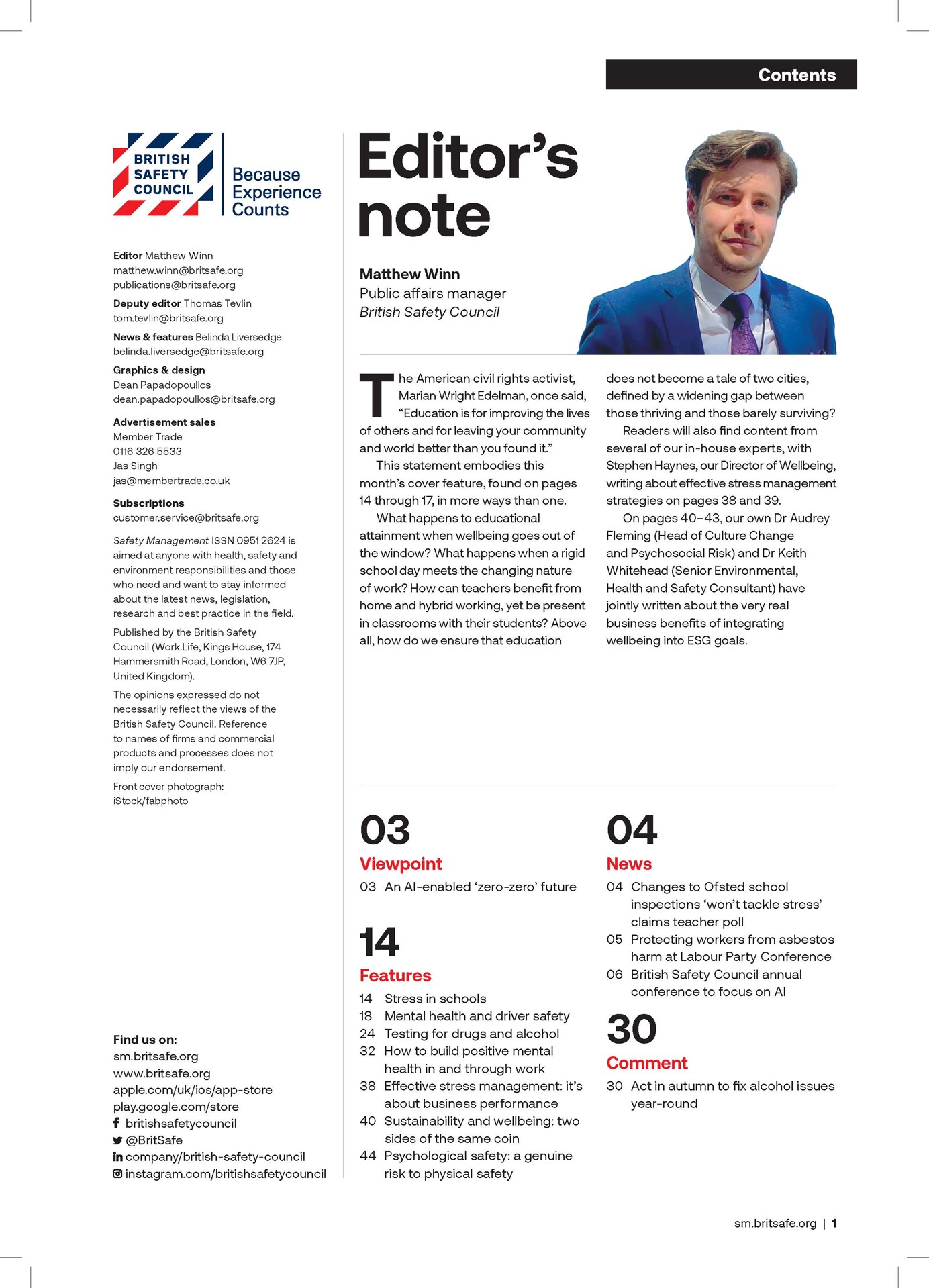With World Mental Health Day taking place on 10 October, now is an ideal time for employers to review their approach to supporting employee mental health, focusing on creating a culture of prevention before people reach crisis point.
Features
How to build positive mental health in and through work
Trigger warning: this article mentions suicide.
With Suicide Prevention Day (10 September) just behind us, and with World Mental Health Day (10 October) and Men’s Health Awareness Month (November) ahead of us, now seems a really good time to stop for a moment and reflect on our own contributions to building positive mental health in and through our workplaces.
 Photograph: iStock
Photograph: iStock
So, where is your organisation on its mental health journey?
Before we delve into the detail, it is important to note that:
- Awareness days are important as they remind us that there is still work to do, but we should not limit our focus on these issues to one day, week or month – instead, we should embed them in our everyday working lives.
- Employee Assistance Programmes (EAPs) and occupational health teams, services and helplines are important in supporting employees when they are experiencing mental ill health; however, we should also be focusing on creating cultures of prevention, so that no one reaches crisis point.
- Communication is at the heart of all business, but are you regularly communicating with employees about the mental health provision (for example, an EAP) you have in place? Do you check it is the type of support your employees want? Do you know how often employees engage with the provision?
- Mental Health First Aiders (MHFAs) can play a role in providing vital support; however, organisations should ensure that all employees have the skills, knowledge and confidence to spot the signs of mental ill health, start conversations and signpost support if needed.
- UK legislation covers many business areas, including company law, employment law, health and safety, data protection, and yet, surveys still report that managers are unaware that HSE clearly states “employers have a legal duty to protect workers from stress at work by doing a risk assessment and acting on it. This is the same duty you have to protect people from other health and safety risks.” In addition, employers have a moral duty to manage stress in the workplace, and it makes good business sense too (in terms of reduced absenteeism, presenteeism, staff turnover and associated costs, plus increased productivity).
- Health and safety risk assessments are commonplace; however, our survey found that fewer than 10 per cent of respondents said that their “line managers know how to undertake stress risk assessments and understand when they may be necessary” (almost 70 per cent said they would not). Do you conduct individual stress risk assessments for teams and, where necessary, individuals? And even more importantly, do you carry them out before someone experiences unmanageable stress or burnout? Do your line managers have the skills to recognise when an assessment is required and how to conduct it? Do they have the knowledge and authority to make reasonable work adjustments to reduce work-related stress and support employee mental health, if required?
- Physical safety is covered by the Health and Safety at Work Act 1974, which places a general duty on employers and the self-employed to ensure the health and safety of employees and others affected by their activities, so far as is reasonably practicable. But too often people do not give psychosocial safety the same degree of care and attention.
- CPD (Continuing Professional Development) is often part of people management policies in order to ensure staff keep up-to-date with organisation-related and legal training (for example, GDPR, health and safety), and many employers encourage all staff to engage with continual professional development; but do you give the same emphasis to mental health and wellbeing training? Our survey found that less than 13 per cent of employers said they have provided all employees with general mental health awareness training in the last two years (61 per cent have not).
- Policies that relate to general legislation relevant to day-to-day business operations and good business practice are often in place; however, our survey found that less than 20 per cent of respondents have mental health policies in place (over 46 per cent do not). Do you have a mental health policy?
 Sam Downie is managing director at Mates in Mind
Sam Downie is managing director at Mates in Mind
Why this is important
- Sickness, presenteeism, reduced productivity and staff turnover from poor mental health is estimated to cost UK businesses £51 billion a year.
- Stress, depression or anxiety accounted for 46 per cent of work-related ill health and 55 per cent of all working days lost due to ill health in 2023/24.
- A survey found that, ‘47 per cent of employers said they offer regular workload reviews to their employees, but just 14 per cent of employees said they receive this’.
- ‘Nearly two-thirds of businesses (64 per cent) say they have seen a rise in absenteeism because of employee mental ill health’ and yet ‘less than half (44 per cent) collected data on employee mental health conditions, whether anxiety or depression’. ‘Although slightly more (46 per cent) did collect data on stress-related disorders’.
Embedding a culture of prevention for mental health
You can download a resource to help you build a culture of prevention around mental health in your organisation, from the Mates in Mind website.
The key steps to take are:
- Managers: Gaining management buy-in is an essential first step in ensuring that mental wellbeing is integrated into the organisation. Through open, collaborative and inclusive communication, management can achieve wider organisational buy-in to taking action to support employee mental health and manage any resistance to change.
- Assessment: Assess the current situation, identify any gaps in provision, and determine necessary changes. At Mates in Mind, we encourage our Supporters to start their journey with us by undertaking our specially developed assessment, which will help their organisation determine the gaps which may be preventing them from reaching their desired goals in supporting the mental wellbeing of their teams. These gaps can exist in knowledge, practices or skills. Knowing what is working well and what needs to be developed is an important step towards reaching an organisation’s mental health and wellbeing goals and could also save a life. Further information can be found here.
- Targets: Define your vision and plan how to achieve it. For our Supporters, once they have completed the assessment, we evaluate any opportunities for growth in supporting mental health within their organisation. We provide a personalised report and plan of action, developed specifically for their needs. Our Support Managers work with our Supporters every step of the way to help implement their plan and help their organisation reach its goals.
- Education: Provide the entire workforce with the skills, knowledge, tools and confidence to create a peer support network, which will contribute to building a safer workplace for everyone. For information on:
- Mental health training, including how to start, or manage a conversation, Mental Health First Aid, and workplace health and wellbeing – please click here
- Training and qualifications in health, safety, wellbeing and environmental management – click here. - Support: Offer relevant provisions to enable employees, supply chains and contractors to access the mental health support they need when they need it. However, employers should remember they are not expected to be able to solve all mental ill-health experiences. If you need to signpost to further support, you can find a list of services on our website.
- Communicate: Provide relevant, timely and accessible communication materials to the workforce, demonstrating an open and supportive culture to end the stigma around mental health and encourage conversations. Free posters and resources are available on our website.
- Progress: Review the above stages at least every two years to evaluate the current situation, demonstrate progress and identify new targets for the future.
- Mentoring: Create peer support networks across the organisation, supply chain and/or contractors. The aim is to educate and support all employees, but it’s also important to ensure these networks are not just ‘top down’ but also ‘bottom up’. For example, a senior leader and an apprentice could be a powerful pairing – the senior leader gaining insights into the pressures the apprentice is under, including working and studying at the same time; the apprentice learning about the pressures of senior management. More broadly, effective peer support networks allow ideas for improving and supporting mental health to be exchanged and developed; helping to gain the all-important buy-in from the wider organisation.
- Diversity, Equity and Inclusion (DEI): As part of building and ensuring an inclusive workplace culture, it is vital that a diverse workforce know that their needs – for example, physical, mental, financial, religious and physiological – are known, understood, respected, valued and integrated. DEI is not just about supporting those with protected characteristics, and it must not be a ‘tick box’ exercise – something that is just included on the company website and annual report. Instead, DEI needs to be ingrained in everything the organisation does and says, including the language the organisation uses (for more advice on this topic please download our Changing the Narrative resource).
- Policies: Ensure you not only have the right policies in place, but they are regularly reviewed and updated as circumstances change. The key policies and documents that must be in place include a Mental Health Policy, Individual Stress Risk Assessments (we provide our Supporters with templates for both of these) and the usual policies that help employees understand not only their rights (for example, in terms of sickness, flexible working requests, maternity and paternity entitlements and company policies), but also what is expected of them (for example, in relation to the company’s IT policy, GDPR rules and DEI policies, arrangements and duties). These policies also help to set and reinforce the behaviours and values expected of all employees.
When an organisation has integrated strategies, tools and support across its workforce, which support their employees’ mental health and wellbeing within work, it has the foundations of a culture of prevention.
 Peer support networks allow ideas for supporting mental health to be exchanged and developed. Photograph: iStock
Peer support networks allow ideas for supporting mental health to be exchanged and developed. Photograph: iStock
These actions, combined with improved awareness and understanding of the topics, opportunities for further education around both suicide prevention and mental health, and a commitment to improvement of these from across an organisation, all contribute to creating a workplace culture geared towards ongoing prevention of mental ill health.
Also, by creating an open and inclusive culture, employers can empower their workforces to have difficult but important conversations about mental health and suicide. For more advice in this area, see our Suicide Prevention Resource.
If a workforce is made fully aware of how and where they can get support for their mental health, in an environment where they do not feel judged or restricted by stigma, they will feel more able to seek the support they need.
A workplace culture where conversations are encouraged, and mental health and wellbeing are proactively supported by employers, can be crucial in tackling the complex challenges of mental ill health and suicide prevention.
Although many organisations are doing great work in building positive mental health in and through their own workplaces, and whilst we advocate for the creation of workplace cultures that emphasise prevention, we know that deaths by suicide do still happen. Therefore, in order to support organisations through the worst of times, we have created a Post-Suicide Response Guide, which can be downloaded here.
How Mates in Mind can help
At Mates in Mind, we advocate for a preventative approach. We work with organisations to ensure all workers have the knowledge, tools and confidence to recognise mental ill health in themselves and in their colleagues. By normalising conversations about mental health, we can end the stigma that persists and empower people to seek support if and when they need it.
In this article, we have only touched on some of the actions organisations can take to end the stigma of mental ill health, build cultures of protection and create positive mental health in and through work. In addition to the guidance and advice links listed above, please see the following to discover much more about:
- Becoming a Mates in Mind Supporter (this programme is for organisations of any size)
- Becoming a Champion (this programme is for large organisations who want to support their supply chains)
- Free resources that can be downloaded and watched
- Blogs on how organisations, and individuals can optimise mental wellbeing that can be read.
How do we know that the approach and interventions developed by Mates in Mind and implemented by our Supports and Champions work? Please read the case studies at the end of this article to find out.
For more information see:
matesinmind.org
linkedin.com/company/mates-in-mind
@MatesInMind
facebook.com/MatesinMind
Sam Downie is managing director at Mates in Mind.
ADT Workplace – finalist in the 2025 Mates in Mind Impact Awards
ADT Workplace writes: “Mates in Mind has played a critical role in helping ADT Workplace move beyond awareness-raising and toward embedding mental health and wellbeing into the fabric of how we work. Their guidance, resources, and messaging have not only shaped our internal approach but have also given us the confidence to extend that impact into the supply chain and wider industry.
“Our journey towards creating a mentally healthy workplace began in 2019, and we’ve continued to evolve ever since – listening, learning, and embedding wellbeing into our culture through daily actions.
“This work is not a one-off campaign – it is supported and resourced at the highest level,
as evidenced by our signed Psychosocial Risk Policy, and delivered on the ground by managers, operatives, and supply chain partners alike. Our leadership team ensures that wellbeing remains a priority by allocating time, people, and financial resources, making it clear that mental health is part of our strategic direction.
“Through our ADT Safer Sites commitment, we’ve formally recognised that psychological wellbeing is as critical as physical safety. Mental health is built into our audits, our training, our culture – and is visible on every site.
“We are proud of the progress we’ve made – but we are not standing still. Continuous improvement is embedded into our approach, and we are already planning further actions, including the integration of wellbeing into subcontractor pre-qualification and additional tools for feedback and early intervention."
Murphy Group – finalist in the 2025 Mates in Mind Impact Awards
Murphy Group writes: “We have made a commitment to prioritise the provision of an inclusive, supportive, and high-quality working environment that promotes physical, psychological, social, and emotional wellbeing for everyone engaged. This we believe, begins with empowering people with the knowledge and skills to support people physically and mentally at work.
“We began our journey with Mates in Mind over 10 years ago with Start and Manage the Conversation training being rolled out. We began to offer Start the Conversation training in house, and this also kicked off the health and wellbeing training that is now thriving today. It is a credit to the workforce that we have so many willing colleagues to step up and undertake training to better support themselves and others. They are so much more empowered and confident to step in when needed, and this is evidenced by the amount of anonymous conversations and interventions that are recorded, as well as feedback from those who have sought help.
“Some of the feedback we have received includes:
- "MHFA (Mental Health First Aid): “This course was exceptional, and I really feel it made me open my eyes to the full range of mental illness and give me a better understanding of the different symptoms. I feel that going forward I will now be able to use the skills I have learnt to be more mindful of other people’s mental health and feelings and enable me to be able to help others in their time of need.”
- "One Day MHFA: “My exposure/knowledge of mental health wasn’t that high entering the course but after this course I feel more informed and armed with information and the tools to identify and manage mental health conditions. The course was well structured and Ann-Marie and Fiona both ensured the subject matter was understood and delivered in a knowledgeable professional way, a really enjoyable, educational session”.”
Additional Supporter feedback
- “Several members have decided to support Mates in Mind and see them as guiding light in changing the sectors approach to mental health. Their resources and frameworks in shaping conversations around workplace wellbeing inspired us to take bold steps in making mental health education universally accessible. Their support and resources helped us align our content with best practices and ensure it resonates with real workplace challenges.”
- “We joined Mates in Mind in 2019… we did not have wellbeing provisions at the time and knew that introducing new training was an opportunity to share important messages about managing mental health… we have also completed the Mates in Mind organisational assessment, which has helped to introduce further wellbeing initiatives… we have felt cultural shifts on-site, receiving feedback from participants of the training that it has become a reliable source of information to take into their lives, professionally and personally.”
- “Since becoming a Mates in Mind Supporter, we have already noticed a positive shift within our workforce. We have noticed open conversations and discussions around the topic of mental health have become more frequent creating an environment where employees feel safe to share their experiences.”
FEATURES

Why menstruation support matters at work
By Deborah Garlick, Menstruation Friendly by Henpicked on 03 December 2025
Although forward-thinking organisations are increasingly taking action on menopause awareness and support at work, attention is now turning to menstrual health as the next essential step in building an inclusive, equitable and high-performing workplace.

Neurodiversity at work: getting started on creating a supportive environment for neurodivergent workers
By Andy Hooke CMIOSH Chartered health and safety consultant on 03 December 2025
Creating a neuroinclusive workplace brings many benefits, including making neurodivergent employees more comfortable about seeking help and support from managers and colleagues, and there are some simple ways of getting started with the process.

Human-centred technology for better work design: rethinking musculoskeletal disorder prevention
By Cam Stevens, Pocketknife Group on 03 December 2025
Although technologies like computer vision analysis, machine learning and wearable sensors are increasingly being used to identify and assess the causes of work-related musculoskeletal disorders (MSDs), it’s essential to consider data relating to all aspects of work design when seeking to reduce MSDs in the workplace.



